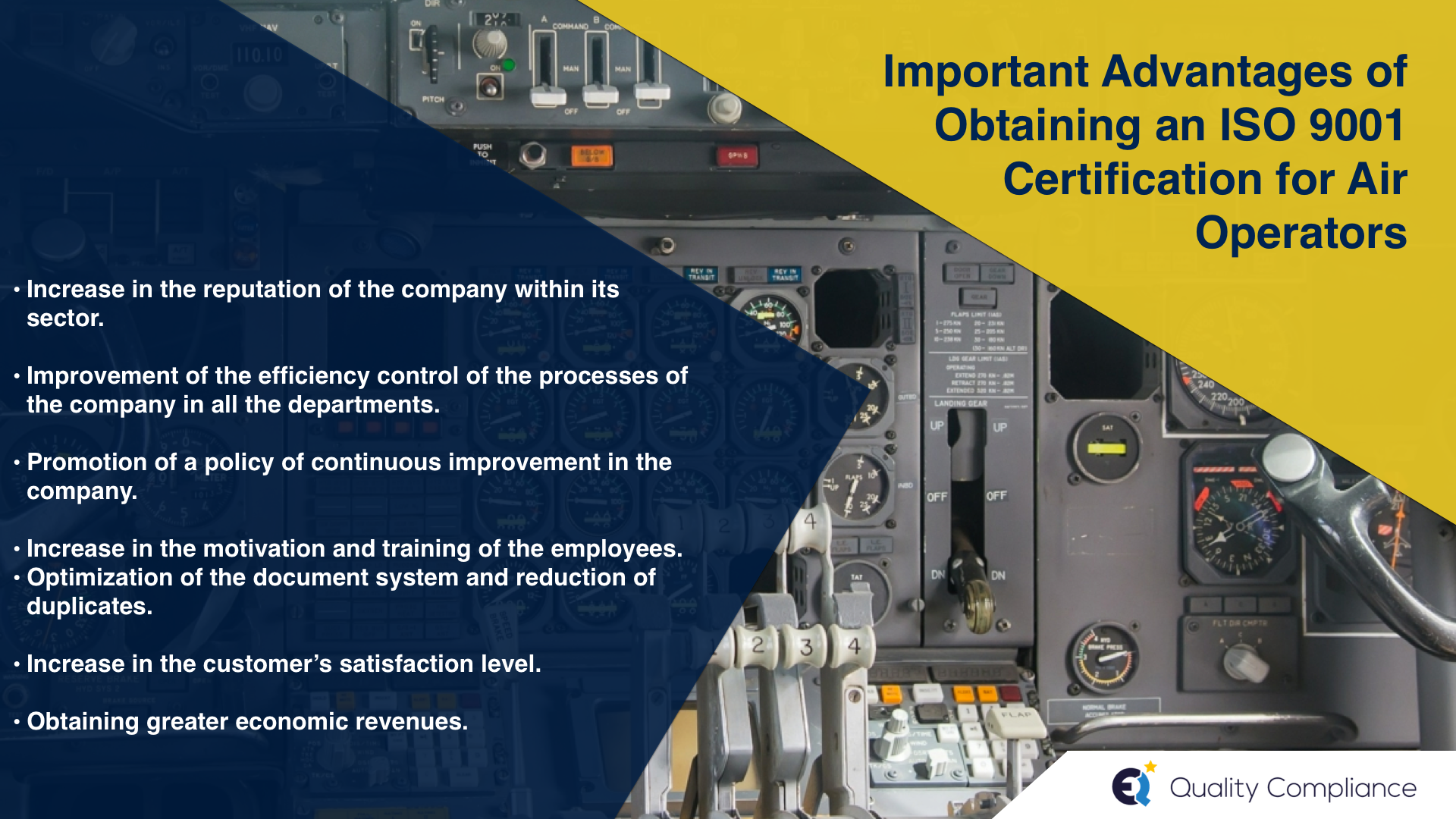The ISO 9001 certification for Air Operators is a standard developed by the International Organization for Standardization (ISO), the most important organization for the global development of voluntary international standards. Its work facilitates world commerce, as it homogenizes the practices of different countries.
In short, the ISO 9001 standard is the one that regulates the quality management systems of the companies, whichever their nature. The certification in this standard has a high demand, as it adds a guarantee for the services offered and it increases the confidence of potential customers.

As a clarification, we must highlight that the quality management to which the ISO 9001 is associated to is not the same that the one associated with the quality and compliance monitoring used by the companies in the aviation sector. ISO 9001 is a standard adaptable to companies of any nature and it supposes a global improvement in the development of their activities like for example, the documents’ management or the control about customer’s satisfaction. The quality and compliance monitoring in the aviation sector is a function related to the compliance with the requirements issued by authorities and other organizations, usually specific of this sector, that include all the processes related to this compliance, like audits, inspections, non-compliance control, etc.
Some of the most important advantages of obtaining an ISO 9001 certification for Air Operators are:
- Increase in the reputation of the company within its sector.
- Improvement of the efficiency control of the processes of the company in all the departments.
- Promotion of a policy of continuous improvement in the company.
- Increase in the motivation and training of the employees.
- Optimization of the document system and reduction of duplicates.
- Increase in the customer’s satisfaction level.
- Obtaining greater economic revenues.
Unlike other accreditations, it is easy to find certifying companies for the ISO 9001, due to the high demand of their services, as they are not limited to one sector and are applicable for any organization.
Despite this advantage, a company that wishes to be certified in ISO 9001 must follow certain steps before contacting with the certifying company to ensure the compliance with the requirements of the standard. The most important steps to follow in the management of the ISO 9001 certification for air Operators are presented below.
ISO 9001 certification process for Air Operators within the organization
- Initial evaluation: In this stage, a person responsible of the certification is appointed and a working methodology is established for the period of certification and scope of the project, based on an analysis of the company’s processes.
- Compilation and/or creation of the necessary documents: Manuals and procedures related to the functions of the company are compiled and adapted to the requirements of the standard.
- Personnel training: The new procedures are shown to the personnel and the corresponding training is performed.
- Implementation of the quality management system: They begin to perform the usual functions of the company following the guidelines of the new procedures, based on the standard, in which the personnel has been trained.
- Performance of an internal audit: One of the most important steps to follow in the process of the ISO 9001 certification for Air Operators is the performance of an internal audit previous to the certification to detect possible problems in the implementation of the new systems and to make sure they are solved before the following audits needed to complete the process are performed.
- Application of the corrective measures: Based on the results of the internal audit, the measures needed to adapt the company’s performance to the standard requirements are implemented.
- Pre-audit and certification audit: An audit is performed, previous to the certification, usually by an organization outside the company, to allow the latest corrections that are necessary. In case that a nonconformity is detected, the pertinent correcting measures should be applied, and a pre-audit should be requested again. If there are no nonconformities detected, a certification audit is requested.
- Certification of the quality management system: The certification audit is performed to verify that the airline complies with the requirements of the ISO 9001 regulations. In case any nonconformity is detected, you have a period of 30 days to correct it. If there are no nonconformities detected, the certification is obtained.
Software for the ISO 9001 audit for an air operator
The ISO 9001 certification in the aviation sector is of high relevance, as it is a common requirement when establishing business collaborations between companies, among other advantages.
The creation or modification of a quality management system in the aviation sector is a hard task, due to the complex working structures of many airlines.
One choice that can help alleviate the workload associated with this certification is to use software like SICOMO that supports the highest possible number of tasks related with the quality and compliance monitoring, like regulations and other updated standards, management of audits plans and its performance, management of the non-compliances, reports generation, etc.
An Automatic Quality Management provides multiple benefits that translate into a higher performance of the ISO 9001 Systems for air operators. If you want to know more about how to certify an Air Operator Certificate (AOC) in EASA, what tools are available to successfully manage the audits and the ISO 9001 certification for air operators and the steps you should follow for the quality management, we invite you to subscribe to the Easa Quality Compliance Newsletter.



